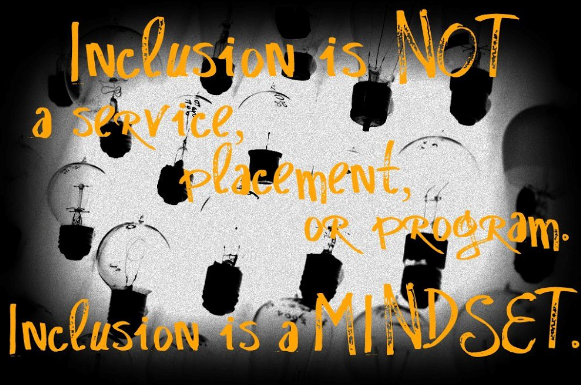Session 2. Models of Disability and Special Educational Needs

1. INDIVIDUALLY. Check what you know. Read the following questions and brainstorm answers:
1. What are special educational needs (SEN)? What categories of people have them?
2. What is a disability? What categories of people have them?
3. What term is broader?
2. IN GROUPS OF 3. Read the following information, share and answer the questions above:
VARIANT 1.
a) The term 'special educational needs' includes disabled and gifted children, street and working children, children from remote or nomadic populations, children from linguistic, ethnic or cultural minorities and children from other disadvantaged or marginalized areas or groups. These conditions create a range of different challenges to school systems.
(From: THE SALAMANCA STATEMENT AND FRAMEWORK FOR ACTION ON SPECIAL NEEDS EDUCATION)
b) According to the Law of Ukraine "On Education", a person with special educational needs is a person who requires additional constant or temporary support in the educational process aimed to uphold his or her right for education (paragraph 20 part 1 article 1).
(From: Закон України "Про освіту")
c) According to the Law of Ukraine "On Education" the categories of persons with special educational needs are defined by decrees of the Cabinet of Ministers of Ukraine taking into consideration international norms and standards.
(From: Закон України "Про освіту")
d) A disability is any condition of the body or mind (impairment) that makes it more difficult for the person with the condition to do certain activities (activity limitation) and interact with the world around them (participation restrictions).
(From: Disability and Health Overview)
VARIANT 2.
e) According to the Decree "The list of some categories of persons with special educational needs" these categories include:
- persons with vision, hearing and musculoskeletal system disorders;
- nervous system diseases;
- global developmental delay, intellectual disorders, severe speech-and sound disorders (including dyslexia);
- other complex developmental disorders (including Autism Spectrum Disorders);
- persons with a pacemaker (електрокардіостимулятор) implanted;
- persons who have conditions preventing them from the passage of External Independent Evaluation (including the lack of the knowledge of the Ukrainian or any other Slavic languages);
f) The categories of disability are usually associated with:
- Vision loss
- Hearing loss
- Musculoskeletal (locomotor) disorders
- Intellectual disorders
- Speech and sound disorders
- Diseases of internal organs
VARIANT 3.
g) According to the Decree "The list of some categories of persons with special educational needs" these categories include:
- persons who require constant medical care or systematic medical procedures to ensure their wellbeing or recovery in medical institutions;
- persons who found themselves in unfavourable living conditions, are enrolled into orphanages of a family type, social and rehabilitation centers, schools of social rehabilitation;
- persons who live on temporarily occupied territories or in localities near the front line where the official authorities do not exercise their powers;
- children-refugees and children that require temporary or permanent defence;
- persons who obtain specialised education and / or can quickly learn the content of specific subjects of one or several grades or levels of secondary education;
- persons obtaining the comprehensive secondary education in a language that does not belong to the Slavic group of languages, or the basic or profile secondary education in a language of indigenous peoples.
(From: Про затвердження Переліку деяких категорій осіб з особливими освітніми потребами)
3. INDIVIDUALLY. Summarise what 4 general categories of people have special educational needs.
Do the quizzes to expand your knowledge:
https://wordwall.net/resource/73836893/types-of-disabilities
https://wordwall.net/resource/65045644/disability-vocabulary-quiz
Decide what categories of persons with disability are likely to have special educational needs at an English lesson.
4. IN PAIRS. Look at the following saying. What does it mean?
 5. INDIVIDUALLY. Read the following text and choose one or several models of disability that characterise your attitude.
5. INDIVIDUALLY. Read the following text and choose one or several models of disability that characterise your attitude.
According to different mindsets people tend to think of a place / role for persons with disability in the society. To describe this phenomenon social scientists single out specific MODELS OF DISABILITY. Their number is endless but most of them can be formalised in the following classification:
- Religious model - persons with disability have it as a result of a sin, so they should be hidden, isolated or killed not to spoil the reputation of their family.
- Charity model - they should look and behave in as miserable way as possible to get the most of charity foundations and individual donations. Their work is out of question.
- Medical model - they should live according to their doctors' recommendations. They are viewed as dependent patients who spend most of their lives in hospitals or treated at home.
- Rehabilitation model - they should be rehabilitated until they recover but if they cannot (it is impossible to grow a missing limb), they should stay at home as "subnormal".
- Economic model - they are unprofitable for the state due to the subsidies they get. That is why if they want to be considered "normal", they should refuse to get these money.
- Social model - disability is a normal form of human diversity. The society has to create such conditions which will enable them to become as independent and self-sufficient as possible. It means to remove all barriers.
- Handicap model - the society should give them some advantages that will help them to become more self-dependent, like: the first places in parking lots, front seats in public transport etc.).
- British model - all the vital objects of the social infrastructure should be accessible in every district, village (e.g. hospitals, medical centers, shops, bus stops) to give people with disability maximal independence.
- Cultural model - due to their peculiarities they are representatives of special culture that should be valued and studied (like Paralympics, arts, Braille alphabet, sign languages etc.).
- Legal model - persons with disabilities have rights that are listed in the international documents (all of which are ratified in Ukraine). Due to these they can stand up for the sufficient level of education, living and working conditions etc.
6. IN FLEXIBLE GROUPS: Explain what your disability model is and why you have chosen it.
7. IN PAIRS. Solve the following quiz:
https://wordwall.net/resource/52408436/medical-model-vs-social-model-of-disability
8. AS A GROUP. Political correctness rules.There is a rule of political correctness in addressing people with disability. Say "WHO" then add "WITH WHAT", e.g. "a person with disability".
Which of the following are politically correct?
- Mentally defective, learning need, feeble-minded, learning difficulty, subnormal, defective, a child with hearing loss, special educational needs, a person with a global developmental delay, additional educational needs, educationally subnormal.
- Інвалід, дитина-інвалід, особа з інвалідністю, дитина з інвалідністю, особа з порушеннями мовлення, аутист, ДЦП-шник, неповносправний, глухі, сліпі, незрячі, люди з інтелектуальними порушеннями, люди з психічними порушеннями, даун, імбіцил, каліка, людина з ампутацією, контужений, людина з контузією, розумово відстала особа.
Is it possible to identify what models of disability (isolation or integration) a person propagates according to the way he or she tags people with disability? In what way?
